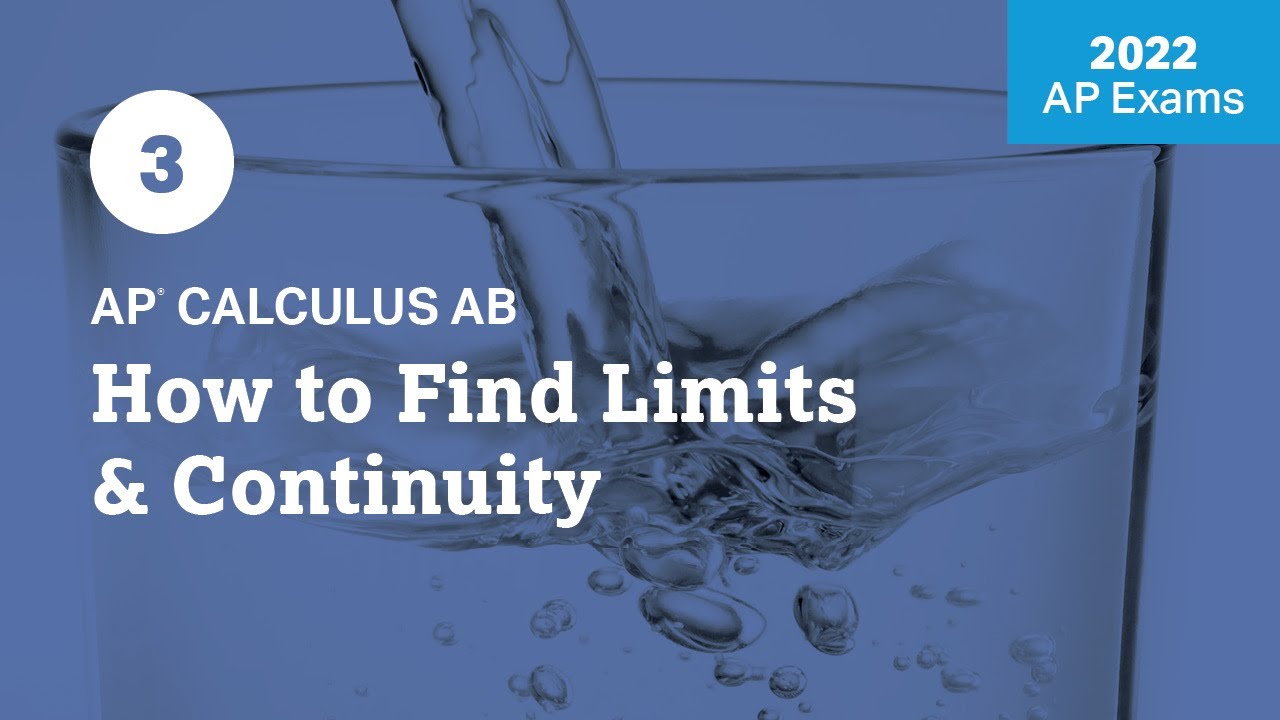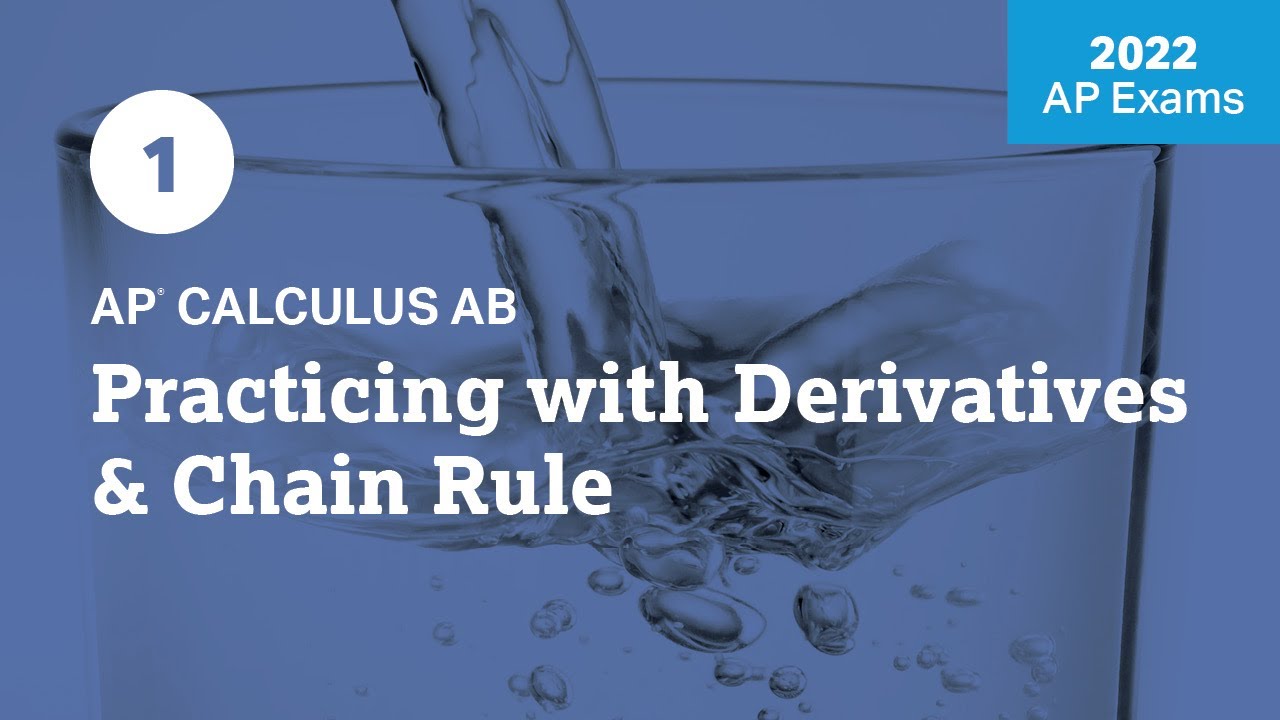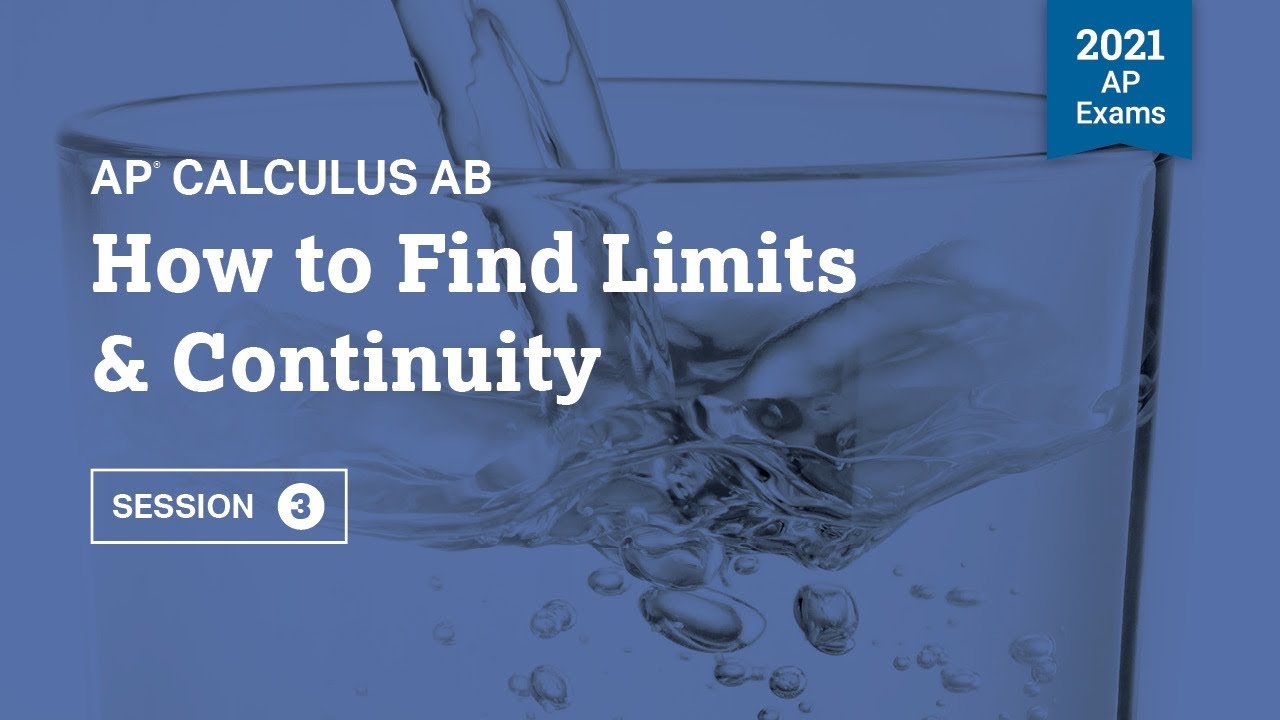8 | FRQ (No Calculator) | Practice Sessions | AP Calculus AB
TLDRIn this engaging video transcript, educators Mark Kiraly and Virge Cornelius collaborate to solve a series of calculus problems, specifically focusing on Calculus AB. The session begins with a discussion on the joy of tackling free response questions, which they describe as a 'medley' of mathematical concepts. Throughout the session, they delve into various calculus topics, including the application of the product rule, the chain rule, and the use of L'Hopital's rule for limits. The educators emphasize the importance of careful reading and writing, as well as showing work to justify answers. They also provide valuable advice for students preparing for the AP Calculus exam, such as practicing with different types of problems and utilizing additional resources like the extended videos available in AP Classroom. The session concludes with words of encouragement and a reminder to practice diligently for the exam.
Takeaways
- 📚 **Read Carefully**: Pay close attention to the problem statement and given information to understand what is being asked.
- 📝 **Write Down Everything**: Encourage students to write down all steps during the exam, even if they can do it mentally, to ensure no points are lost.
- 🔢 **Product Rule**: When differentiating a product of two functions, use the product rule, which involves multiplying the first function by the derivative of the second and vice versa, then adding the results.
- 🔗 **Chain Rule**: For composite functions, apply the chain rule, which means differentiating the outer function and multiplying by the derivative of the inner function.
- ↔️ **Inverse Functions**: Understand the relationship between a function and its inverse, and how their derivatives are reciprocals of each other.
- 🏁 **Direct Substitution**: When evaluating limits, always try direct substitution first before resorting to techniques like L'Hôpital's rule.
- ⚠️ **Indeterminate Forms**: Recognize when direct substitution results in an indeterminate form, such as 0/0 or ∞/∞, which may require further methods like L'Hôpital's rule.
- 🔁 **Reciprocal Slopes**: For inverse functions, the slopes are reciprocal, which is a key concept when finding the derivative of an inverse function.
- 📉 **Evaluate Functions**: When dealing with functions, evaluate them at the given points to find the necessary values for further calculations.
- 🧮 **Practice and Review**: Encourage students to practice and review all the concepts taught throughout the course, including algebra, trigonometry, and calculus.
- 📈 **Use All Resources**: Utilize additional resources like AP Classroom and previous year's videos for extra review and to reinforce learning.
Q & A
What subject are Mark Kiraly and Virge Cornelius discussing in their session?
-They are discussing Calculus AB, specifically working on a free response question involving multiple representations and the product rule.
Why does Virge Cornelius encourage students to write everything down during the exam?
-Virge Cornelius encourages students to write everything down to ensure they don't lose points, as different parts of the exam are worth certain points and it's important to show all work for full credit.
What mathematical concept does Mark Kiraly mention when discussing the first video?
-Mark Kiraly mentions the product rule, which is a fundamental rule in calculus for finding the derivative of a product of two functions.
What is the significance of the '0 sandwich' that Virge Cornelius talks about?
-The '0 sandwich' refers to the indeterminate form of 0/0 that occurs when both the numerator and denominator of a limit approach zero. This situation often allows the use of L'Hôpital's rule to find the limit.
Why is direct substitution the first step when evaluating limits?
-Direct substitution is the first step because it can often simplify the expression and provide the answer immediately. It's also a way to check for cases where the limit might be undefined or infinity, without immediately resorting to more complex methods like L'Hôpital's rule.
What is the final answer that Virge Cornelius finds for the limit question in part D?
-The final answer for the limit question in part D is 5/2, or 2.5.
What does Mark Kiraly emphasize about the importance of reading and writing carefully?
-Mark Kiraly emphasizes that careful reading helps students form a clear image of the problem, and careful writing ensures that all work is shown and answers are justified, which is crucial for exams.
What advice do Mark Kiraly and Virge Cornelius give to students regarding additional review for the AP exam?
-They advise students to go back and watch all the videos in the series if they haven't already, as these cover a range of topics that frequently appear on the AP exam. They also mention that longer videos from 2021 and 2022 are available in AP Classroom for further review.
What is the role of the chain rule in the session when finding derivatives?
-The chain rule is used when finding the derivatives of composite functions, such as when differentiating C(x) = 5b(a(x)) or when differentiating the function involving cosine and pi*x, which requires applying the chain rule to account for the composition of functions.
How do Mark Kiraly and Virge Cornelius demonstrate the use of the product rule in finding the derivative of P(x)?
-They apply the product rule directly to the function P(x) = a(x) * b(x), where they multiply the first function by the derivative of the second and add it to the second function times the derivative of the first, then substitute the value of x = -3 to find P'(-3).
What is the relationship between the slopes of inverse functions that Virge Cornelius discusses?
-The relationship between the slopes of inverse functions is that they are reciprocal to each other. This means that if the slope of the original function at a certain point is 'm', the slope of the inverse function at the corresponding point will be '1/m'.
Outlines
📚 Calculus AB Session with Virge and Mark
In the first paragraph, Mark Kiraly and Virge Cornelius, teachers from different schools, introduce the last session of their calculus series. They are set to discuss a free response question involving Calculus AB. Virge expresses his enthusiasm for the subject and the type of question they will be tackling, which he describes as a mixed bag of mathematical concepts. Mark encourages viewers to pause and absorb the information presented in the video. The problem they are addressing involves finding the derivative of a product of two functions, which leads them to use the product rule. They also discuss the importance of writing down all steps during an exam to ensure no points are lost.
🔢 Applying Product and Chain Rules in Calculus
The second paragraph continues the calculus problem-solving approach. They delve into evaluating a function defined as the product of two other functions at a specific point. Virge demonstrates the application of the product rule and the chain rule to find derivatives, emphasizing the importance of showing all work for clarity and to maximize exam scores. Mark agrees with Virge's approach and encourages students to practice these techniques. They also touch on a question involving the derivative of a composed function, highlighting the necessity of the chain rule in such scenarios.
🧐 Inverse Functions and Limits in Calculus
In the third paragraph, the discussion shifts to inverse functions and limits. Virge and Mark explore finding the derivative of an inverse function and the value of a limit as x approaches a certain value. They use the concept of reciprocal slopes for inverse functions and address the scenario of an indeterminate form in limits, suggesting the use of L'Hopital's rule. The paragraph emphasizes the need for direct substitution first before applying more complex rules like L'Hopital's rule. They also stress the importance of understanding the underlying concepts and practicing problems thoroughly.
🎓 Final Thoughts and Encouragement for Exam Preparation
The final paragraph wraps up the session with key takeaways and encouragement for students. Both teachers stress the importance of careful reading and writing, as well as justifying answers with clear work shown. They acknowledge the progress students have made since the beginning of the course and provide a summary of the different representations they have covered in their series. Virge and Mark also direct students to additional resources for further review, expressing their confidence in the students' ability to succeed on the exam with enough practice and preparation.
Mindmap
Keywords
💡Calculus AB
💡Free response question
💡Product rule
💡Chain rule
💡Inverse function
💡Derivative
💡Limit
💡L'Hôpital's rule
💡Direct substitution
💡Multiple representation
💡AP Classroom
Highlights
The session focuses on Calculus AB, emphasizing the importance of understanding multiple representations of calculus problems.
Virge Cornelius and Mark Kiraly, teachers from different schools, collaborate to solve a calculus problem, demonstrating a medley of mathematical approaches.
The transcript showcases the application of the product rule in calculus, a fundamental concept that is revisited from an earlier session.
Mark Kiraly emphasizes the importance of downloading or pausing the screen to absorb the given information in the problem stem.
The session includes a detailed walkthrough of finding the derivative of a product of two functions, using the product rule.
Virge Cornelius discusses the concept of writing down every step during an exam to avoid losing points, even if the calculation can be done mentally.
Mark Kiraly recalls a previous video where the same technique was used, highlighting the importance of remembering past problem-solving strategies.
The transcript illustrates the use of the chain rule in calculus when dealing with composite functions.
Virge Cornelius explains how to handle a limit calculation as x approaches a certain value, including the potential need for L'Hôpital's rule.
Mark Kiraly suggests always trying direct substitution for limits before resorting to more complex methods like L'Hôpital's rule.
The session demonstrates the concept of reciprocal slopes when dealing with inverse functions and their derivatives.
Virge Cornelius and Mark Kiraly provide a step-by-step justification for using L'Hôpital's rule in a limit problem, emphasizing the importance of showing work.
The transcript highlights the need for careful reading and writing in solving calculus problems, as well as the importance of practice and understanding of algebra and trigonometry.
The session concludes with encouragement for students to practice and utilize additional resources like AP Classroom for more comprehensive review.
Virge Cornelius expresses confidence in students' ability to pass the exam with enough practice, underlining the progress made since the beginning of the course.
Mark Kiraly and Virge Cornelius provide a summary of key takeaways, including the importance of direct substitution, understanding of algebra and trigonometry, and the use of various calculus representations.
The session ends with a reminder to students that they have access to longer videos for further review and that initiative and self-study are crucial for success.
Transcripts
Browse More Related Video

1 | MCQ | Practice Sessions | AP Calculus AB

2021 Live Review 1 | AP Calculus AB | Understanding Derivatives & Chain Rule

2022 Live Review 3 | AP Calculus AB | How to Find Limits & Continuity

2022 Live Review 1 | AP Calculus AB | Practicing with Derivatives & Chain Rule

Monday Night Calculus: Reviewing for the AP exam

2021 Live Review 3 | AP Calculus AB | How to Find Limits & Continuity
5.0 / 5 (0 votes)
Thanks for rating: